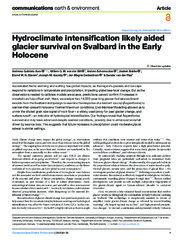| dc.contributor.author | Auer, Andreea-Gabriela | |
| dc.contributor.author | van der Bilt, Willem Godert Maria | |
| dc.contributor.author | Schomacker, Anders | |
| dc.contributor.author | Bakke, Jostein | |
| dc.contributor.author | Støren, Eivind W. N. | |
| dc.contributor.author | Buckby, Joseph | |
| dc.contributor.author | Cederstrøm, Jan Magne | |
| dc.contributor.author | van der Plas, Sander | |
| dc.date.accessioned | 2025-02-14T12:16:25Z | |
| dc.date.available | 2025-02-14T12:16:25Z | |
| dc.date.issued | 2025-02-11 | |
| dc.description.abstract | Accelerated Arctic warming and wetting has global impacts, as the region’s glaciers and ice caps
respond to variations in temperature and precipitation, impacting global sea-level change. But as the
observations needed to calibrate models are scarce, predictions cannot confirm if increases in
snowfall can help offset melt. Here, we analyze two 14,000-year-long glacier-fed lake sediment
records from the Svalbard archipelago to examine the response of a resilient ice cap (Åsgardfonna) to
warmer-than-present Holocene Thermal Maximum conditions. End-Member Modelling allowed us to
unmix the diluted grain size signal of rock flour – a widely used proxy for past glacier change, and
surface runoff – an indicator of hydrological intensification. Our findings reveal that Åsgardfonna
survived and may have advanced despite warmer conditions, possibly due to enhanced snowfall
driven by sea-ice loss. This suggests that future increases in precipitation could moderate glacier
retreat in similar settings. | en_US |
| dc.identifier.citation | Auer, van der Bilt, Schomacker, Bakke, Støren, Buckby, Cederstrøm, van der Plas. Hydroclimate intensification likely aided glacier survival on Svalbard in the Early Holocene. Communications Earth & Environment. 2025;6:1-14 | en_US |
| dc.identifier.cristinID | FRIDAID 2358860 | |
| dc.identifier.doi | 10.1038/s43247-025-02064-z | |
| dc.identifier.issn | 2662-4435 | |
| dc.identifier.uri | https://hdl.handle.net/10037/36510 | |
| dc.language.iso | eng | en_US |
| dc.publisher | Springer Nature | en_US |
| dc.relation.journal | Communications Earth & Environment | |
| dc.rights.accessRights | openAccess | en_US |
| dc.rights.holder | Copyright 2025 The Author(s) | en_US |
| dc.rights.uri | https://creativecommons.org/licenses/by/4.0 | en_US |
| dc.rights | Attribution 4.0 International (CC BY 4.0) | en_US |
| dc.title | Hydroclimate intensification likely aided glacier survival on Svalbard in the Early Holocene | en_US |
| dc.type.version | publishedVersion | en_US |
| dc.type | Journal article | en_US |
| dc.type | Tidsskriftartikkel | en_US |
| dc.type | Peer reviewed | en_US |


 English
English norsk
norsk
